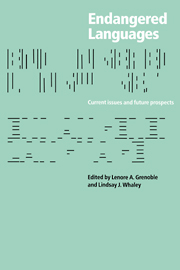Book contents
- Frontmatter
- Contents
- Preface
- List of abbreviations and symbols
- Part I General issues
- Part II Language-community responses
- 3 Technical, emotional, and ideological issues in reversing language shift: examples from Southeast Alaska
- 4 Mayan efforts toward language preservation
- 5 A chronology of Mohawk language instruction at Kahnawà:ke
- 6 Language endangerment in South America: a programmatic approach
- Part III What is lost: language diversity
- Part IV Mechanisms of language loss
- Appendix
- References
- Index of languages
- Index of names
- General index
3 - Technical, emotional, and ideological issues in reversing language shift: examples from Southeast Alaska
Published online by Cambridge University Press: 05 June 2012
- Frontmatter
- Contents
- Preface
- List of abbreviations and symbols
- Part I General issues
- Part II Language-community responses
- 3 Technical, emotional, and ideological issues in reversing language shift: examples from Southeast Alaska
- 4 Mayan efforts toward language preservation
- 5 A chronology of Mohawk language instruction at Kahnawà:ke
- 6 Language endangerment in South America: a programmatic approach
- Part III What is lost: language diversity
- Part IV Mechanisms of language loss
- Appendix
- References
- Index of languages
- Index of names
- General index
Summary
Introduction
Native American people across the nation have expressed concern over the loss of indigenous languages, and they have expressed a desire to do something to prevent it. The loss of small, tribal languages is a worldwide phenomenon and an international concern. In Alaska, only two of the twenty Native languages are now being learned by children in the traditional way of parents speaking to children (Krauss 1995b 12–3). If this trend continues, the other eighteen languages will eventually die. Unfortunately, it is not easy to understand and appreciate the process by which languages are lost, the actions we must take to prevent such loss, or the actions we must take to preserve and/or restore endangered languages.
This has been a difficult chapter to write because most of the examples are of failures: things that have gone wrong or that have not worked. We have been personally involved in the dynamics described in this chapter in language research, teacher training, and materials development. As part of that picture, we have contributed to the failures as well as the successes in the general language-restoration effort of the last quarter century. But this chapter is composed in the spirit of optimism. Its goal is to involve all of us in values clarification and to unite us in making informed choices and in taking timely and appropriate action. Hopefully, we all can learn through our mistakes and realign our courses while there is still time.
- Type
- Chapter
- Information
- Endangered LanguagesLanguage Loss and Community Response, pp. 57 - 98Publisher: Cambridge University PressPrint publication year: 1998
- 86
- Cited by



